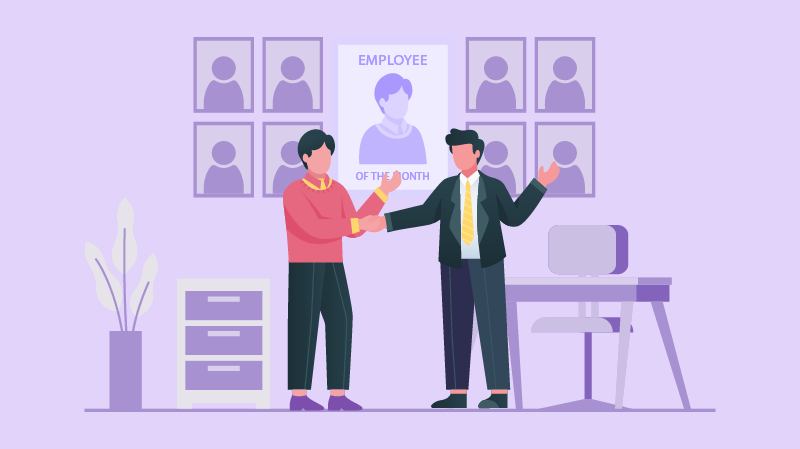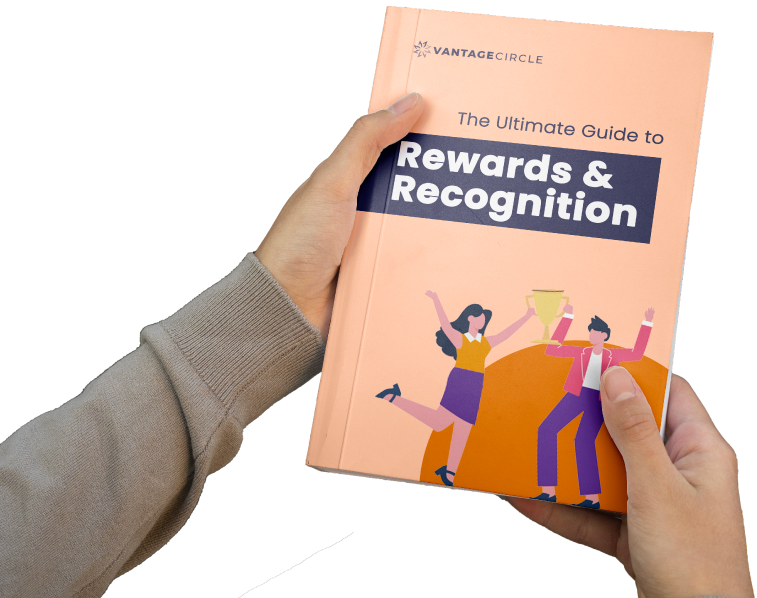More Than a Thank You: The Cultural Power of Symbolic Recognition

A Global Employee Recognition and Wellness Platform
Most leaders live in a misconception , they think the best employees leave for more money, when the real reason is much simpler, they leave because they feel invisible.
I learned this the hard way watching a brilliant software engineer quit our company three years ago. She didn't leave for a bigger salary (her new job actually paid less). She left because in eighteen months with us, not once did anyone acknowledge the late nights she pulled to save a critical client project, or the elegant code solutions that made everyone else's job easier.
Meanwhile, in another instance, our marketing coordinator had turned down two higher-paying offers that same year. Why? Because every time she created something that moved the needle, we found a way to celebrate it—not with cash, but with recognition that showed we truly saw her impact.
The difference between these two outcomes? One person felt like a replaceable resource. the other felt like an irreplaceable human being.
This isn't a story about good intentions or nice-to-have employee perks. It's about understanding that in today's talent market, meaningful recognition isn't just a retention strategy—it's your competitive advantage.
Here's a sobering reality check: only 31% of employees are engaged at work in 2024, matching the lowest level seen in a decade. Yet 86% of value-based recognition programs show an increase in workers’ happiness. This gap represents the biggest untapped opportunity in modern business.
In this deep dive, we'll discuss why symbolic recognition works and can give you a practical roadmap for creating recognition that actually sticks. Because the difference between a thriving team and a revolving door often comes down to whether people feel truly seen.
What is Symbolic Recognition?

Symbolic recognition is a form of employee recognition that goes beyond material rewards—it's about meaningful, personalized gestures that acknowledge effort, impact, and alignment with company values.
What Makes Recognition Actually Symbolic
Unlike transactional rewards (like bonuses or gift cards), symbolic recognition creates an emotional connection. It says: “We see you—not just for what you did, but for who you are and how you contribute to our culture.”
Key Characterstics of Symbolic Recognition:
- Intentional
- Personalized
- Value-based
- Memorable
From Generic Trophies to Meaningful Artifacts
Here's the thing about most workplace awards: they're forgettable because they're interchangeable.
The difference is intention. Meaningful artifacts carry weight because they're designed to represent something specific about your contribution and your company's identity.
Weaving Individual Wins into Your Company's Story
The most powerful recognition doesn't just celebrate what someone did—it shows how what they did fits into the bigger picture. When you connect individual achievements to your company's mission, you're not just saying "good job." You're saying "you're essential to our success."
From Annual Reviews to Everyday Moments
Remember when recognition meant waiting months to hear if you'd done well? The companies winning today have moved from those rigid, once-a-year rituals to something much more dynamic and immediate.
This shift from transactional recognition ("here's your bonus") to relational recognition ("here's why you matter") changes the entire employee experience. It transforms recognition from a business process into a cultural cornerstone.
The Evolution of Employee Recognition: From Annual Bonuses to Continuous Recognition
The traditional annual review cycle is dying, and for good reason. Progressive organizations are shifting to continuous recognition models where symbolic appreciation happens in real-time. This isn't about participation trophies or participation culture ; it's about catching excellence real time.
The Shift from Transactional to Relational Recognition
Each symbolic recognition moment becomes an opportunity to strengthen the bond between employee and organization.
This shift changes everything. Instead of employees working for rewards, they work for belonging. Instead of chasing individual achievements, they chase collective success. The symbol becomes a badge of membership in something larger than themselves.
Integrating Recognition into the Entire Employee Lifecycle
Symbolic recognition shouldn't start when someone excels – it should begin when they arrive. From onboarding symbols that welcome new team members to milestone markers that celebrate tenure, recognition becomes a continuous thread woven throughout the entire employee experience.
Read More :Types Of Employee Recognition-All You Need To Know
Why Symbolic Recognition Motivates and Connects

Symbolic recognition works because it taps into something deeper than performance reviews or bonuses—it speaks to our fundamental human need for meaning, connection, and identity.
This isn’t just theory. It’s grounded in decades of psychology and neuroscience. When people feel seen, valued, and part of something bigger, they don’t just work—they care.
The Psychology Behind Recognition
We’re wired to seek meaning. Symbolic recognition transforms routine tasks into purposeful contribution. It tells people: you’re not just doing a job, you’re making a difference. That’s how employees become invested contributors.
Maslow: Recognition at the Top of the Pyramid
While pay satisfies basic needs, symbolic recognition fulfills higher ones: esteem and self-actualization. It’s not just about what someone instead it’s about who they are and what they bring to the table.
Herzberg Theory : Why Money Isn’t Enough
Salary prevents dissatisfaction but it doesn’t drive motivation. According to Herzberg’s Two-Factor Theory, true motivation comes from achievement, meaning, and recognition. Symbolic rewards deliver all three.
Self-Determination: Fueling Intrinsic Motivation
Recognition that highlights autonomy, competence, and connection hits the core of intrinsic drive. It says, “We see your effort, your talent, and how it connects to the bigger picture.”
The Neurochemistry of a "Thank You": What Happens in the Brain When We Feel Valued
Recent neuroscience research has revealed the biological mechanisms behind recognition and appreciation. When we feel genuinely valued, our brains release a powerful mix of chemicals that don't just make us feel good – they make us perform better.
Thus , Recognition isn’t just emotional—it’s biological.
The Brain on Recognition: A Chemical Cocktail
-
Dopamine sparks motivation and anticipation
-
Serotonin lifts confidence and emotional well-being
-
Oxytocin deepens trust and social connection
Symbolic recognition activates all three. It doesn’t just feel good in the moment, it creates lasting motivation and reinforces the desire to contribute again.
Creating Psychological Safety Through Consistency
When recognition is consistent and sincere, it builds psychological safety—the foundation of high-performing teams. People feel safer to take risks, share ideas, and show up fully.
Each meaningful gesture sends a clear message:
Your contributions matter. We see you. We value you.
Over time, that message creates a culture where people don’t just work—they thrive.
How Symbolic Awards Drive Business Growth and Success

From Morale to Metrics: The Tangible ROI of a Strong Recognition Culture
Recogniiton helps in boosting Performance, Engagement, and Innovation.
The numbers tell a compelling story. Companies with strong recognition cultures see remarkable business outcomes:
-
84% higher engagement scores compared to companies with weak recognition ( Gallup State of the Global Workplace Report.)
-
12% increase in productivity within teams that receive regular recognition ( Deloitte Global Human Capital Trends)
-
18% higher revenue growth for organizations with engaged workforces ( Harvard Business Review - The Impact of Employee Engagement)
2.3x more likely to be agile and responsive to market changes ( McKinsey Global Institute Research)
But perhaps most importantly, recognized employees are more likely to contribute innovative ideas. When people feel valued, they don't just do their jobs—they actively look for ways to improve processes, solve problems, and drive growth.
The Undeniable Link Between Recognition and Employee Retention
Here's a statistic that should keep every HR leader awake at night: 79% of employees who quit cite "lack of appreciation" as their primary reason for leaving ( Work Institute 2019 Retention Report). Meanwhile, companies with recognition programs have:
-
31% lower voluntary turnover rates ( Society for Human Resource Management (SHRM) Employee Recognition Survey)
-
56% less burnout among employees ( Gallup Q12 Meta-Analysis)
-
5x higher employee net promoter scores ( Temkin Group Employee Engagement Benchmark Study)
When you consider that replacing an employee costs between 50-200% of their annual salary ( Center for American Progress - The Cost of Employee Turnover), recognition isn't just a nice-to-have—it's a financial imperative.
The "Trophy Value": Why Symbolic Recognition Awards Outshine Cash in the Long Run
The Limitations of Monetary Rewards
Research from the University of Chicago shows that 68% of employees can't remember what they spent cash bonuses on within 6 months ( University of Chicago Booth School of Business - Behavioral Economics Study). Money is transactional. It's spent, it's gone, and it becomes just another line item in someone's budget.
Worse, monetary rewards can actually backfire in knowledge work. MIT's research on motivation found that financial incentives can reduce performance on tasks requiring creativity or problem-solving by up to 15% ( MIT Sloan Management Review - Drive: The Surprising Truth About What Motivates Us).
Creating Lasting Emotional Connections and Loyalty
Symbolic recognition creates what psychologists call "emotional stickiness." It's that attachment we form to objects that represent meaningful moments in our lives.
This emotional connection translates directly to business value. Companies that excel at recognition see 40% higher customer satisfaction scores, largely because engaged employees deliver better customer experiences ( Temkin Group Customer Experience Research).
Designing a World-Class Symbolic Awards Program

A truly impactful symbolic recognition program isn’t built for convenience—it’s built for connection. It ties individual achievement to organizational purpose and inspires more of the behaviors that drive business success.
The best programs are strategic, cultural, and intentional—not one-size-fits-all, but deeply human.
5 Core Principles of Meaningful Recognition
- Be Authentic and Specific
Instead of “Thanks for your hard work,” say:
“Your decision to stay late and call every client during the outage shows exactly the kind of customer-first thinking we stand for.”
Specific recognition reinforces values and teaches others what great looks like.
- Personalize the Experience
Some prefer public celebration. Others value private recognition or symbolic keepsakes. Offer meaningful options that reflect different personalities—without losing consistency.
- Recognize in the Moment
Timely recognition strengthens the link between action and appreciation. Build systems to capture excellence while it’s fresh.
- Make It Inclusive and Fair
Be transparent about criteria. Give everyone a chance to be recognized—without lowering standards.
- Align with Your Culture and Values
Symbolic awards should feel like your brand.
Here’s how you can find your company’s own Symbols
Mine Your Culture for Meaning
To find your organization’s symbols, ask questions like:
-
What stories are told again and again?
-
What do people say makes this a special place to work?
-
What moment do you wish every employee could experience?
-
What’s a part of your history you’re most proud of?
-
What image, object, or phrase captures who you are at your best?
Your company’s symbols may already be hiding in plain sight, in your logo, your mission, your tools, or even inside jokes only your team would understand.
Turn Stories Into Symbols
Once you’ve identified the stories that matter most, translate them into visual or physical symbols that prompt pride and connection. Think beyond trophies—symbols can be:
-
Custom tokens
-
Illustrated awards
-
Iconic artifacts from your company’s history
-
Milestone markers
-
Internal badges or emblems
Whatever the format, it should reflect your purpose and values.
Need help creating them? Partner with a design team that understands how to translate culture into craftsmanship.
Use language, symbols, and rituals that reflect who you are. The best programs reinforce—not disrupt—your existing culture.
When recognition feels real, people believe in it. And when people believe in it, it changes everything.
The Art of the Presentation: Making Recognition Moments Matter

A symbolic award is only as powerful as its presentation. A meaningful gesture can fall flat without intention, while even a simple token can become unforgettable with the right delivery.
What Makes Recognition Actually Stick
Let's be honest—most recognition programs fall flat because they feel generic and impersonal. But when you get it right, the impact is incredible.
The most effective recognition programs follow what recognition experts call the AIRe framework: Appreciation, Incentivization, Reinforcement, and Emotional Connect. This approach, developed by Vantage Circle through studying over 120 active recognition programs, ensures that recognition hits all the psychological triggers that create lasting impact.
Public vs. Private Recognition
Public praise inspires others and reinforces cultural values.
- Use it to highlight behaviors you want replicated across the team.
Private acknowledgment creates intimacy and deeper emotional connection.
- Ideal for quieter personalities or sensitive moments.
Use Rituals to Reinforce Culture
Great recognition moments often feel ceremonial—and that’s the point.
A sales bell.
A spotlight at the all-hands.
A personal note delivered with a small keepsake.
Ideal is to Choose rituals that reflect your culture and make people feel valued.
Create a 360° Recognition Culture
Recognition shouldn’t just come from the top. It should flow across all levels—managers, peers, and teams.
1.Peer-to-Peer Recognition
Peers often understand the work best. Their praise feels real and validating.
Make peer recognition easy to give and meaningful to receive.
Use distinct symbols for peer-led awards to keep them special.

2.Team-Based Awards
Symbolic team awards build shared pride and highlight collaboration.
They also recognize quiet contributors who might not otherwise get the spotlight.
Make Recognition Visible
Keep the momentum going with:
-
Digital “walls of fame” in your recognition platform
-
Physical displays in shared spaces
You can implement a phygital recognition approach (a combination of both digital and physical recognition) to reach everyone, including those who aren’t constantly connected.

Real Companies Getting It Right
Here are some orgnizations which have got this right overtime
Disney has turned employee recognition into an art form. Their programs don't just reward good work—they create legends. Employees don't just get awards; they become part of the Disney story.
Yelp takes a completely different approach with their "Wall of Game," mixing humor with heartfelt recognition.
These companies have built programs that reflect their unique cultures while tapping into universal human needs.
How to Avoid Common Recognition Program Failures

Even the best intentions can fall flat without thoughtful execution. Here’s what to watch out for:
Tie Every Symbol to a Specific Story
Always link recognition to a specific achievement or behavior that reflects your company’s values.
Avoid the "One-Size-Fits-All" Trophy
Design awards that reflect different contributions—from innovation to leadership to collaboration.
Establish and Publicize Clear Criteria
Be transparent about what earns recognition and why.
Rotate the Selection Committee
Diversify decision-making. A rotating, inclusive committee prevents bias and ensures broad representation.
Focus on Peer-to-Peer Symbolic Awards
Encourage employees to recognize each other. It makes recognition more democratic and more frequent.
Protect the Symbol's Value
Don’t over-distribute awards. Their value lies in rarity and meaning. Recognize what’s truly exceptional.
Evolve Your Symbols
Keep your program fresh. Tie new awards to evolving business priorities and cultural moments.
Integrate Symbols into Daily Workflow
Make recognition seamless. Use platforms like Slack or Teams to embed symbolic kudos into everyday work life.
The Bottom Line
In a world where people have choices about where to work, companies that make recognition meaningful have a massive advantage. They attract better talent, keep their best people longer, and create cultures where innovation thrives.
Symbolic recognition isn't just about making people feel good—though that's important too. It's about creating an environment where people bring their best selves to work because they know their contributions matter.
The question isn't whether you can afford to invest in meaningful recognition. The question is whether you can afford not to.
Because at the end of the day, people don't just want to work for companies that pay them well. They want to work for companies that see them, value them, and make them proud to be part of something bigger than themselves.
That's the kind of culture that wins in the long run. And it all starts with recognizing that recognition itself is worth recognizing.


















